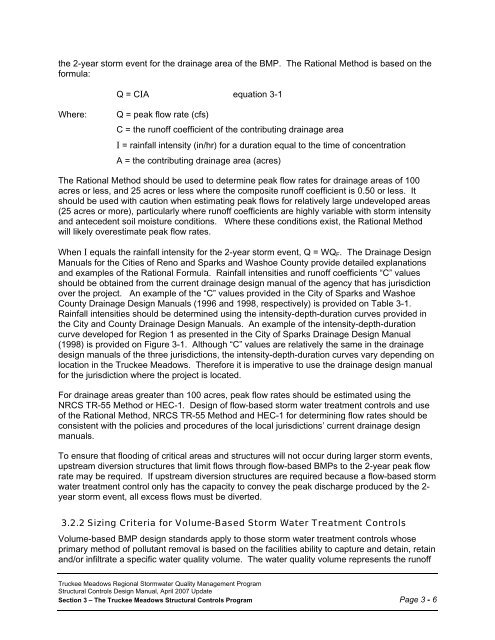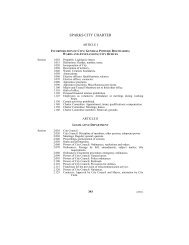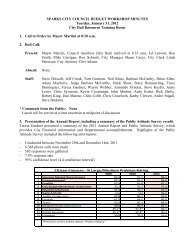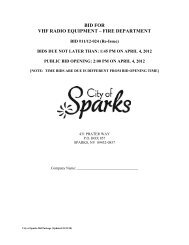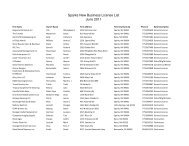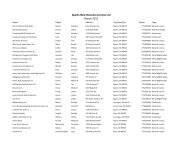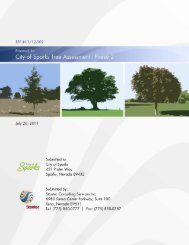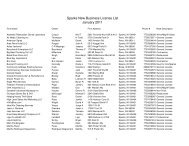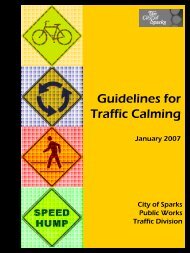The Truckee Meadows Structural Controls Design ... - City of Sparks
The Truckee Meadows Structural Controls Design ... - City of Sparks
The Truckee Meadows Structural Controls Design ... - City of Sparks
You also want an ePaper? Increase the reach of your titles
YUMPU automatically turns print PDFs into web optimized ePapers that Google loves.
the 2-year storm event for the drainage area <strong>of</strong> the BMP. <strong>The</strong> Rational Method is based on the<br />
formula:<br />
Q = CIA equation 3-1<br />
Where: Q = peak flow rate (cfs)<br />
C = the run<strong>of</strong>f coefficient <strong>of</strong> the contributing drainage area<br />
I = rainfall intensity (in/hr) for a duration equal to the time <strong>of</strong> concentration<br />
A = the contributing drainage area (acres)<br />
<strong>The</strong> Rational Method should be used to determine peak flow rates for drainage areas <strong>of</strong> 100<br />
acres or less, and 25 acres or less where the composite run<strong>of</strong>f coefficient is 0.50 or less. It<br />
should be used with caution when estimating peak flows for relatively large undeveloped areas<br />
(25 acres or more), particularly where run<strong>of</strong>f coefficients are highly variable with storm intensity<br />
and antecedent soil moisture conditions. Where these conditions exist, the Rational Method<br />
will likely overestimate peak flow rates.<br />
When I equals the rainfall intensity for the 2-year storm event, Q = WQF. <strong>The</strong> Drainage <strong>Design</strong><br />
Manuals for the Cities <strong>of</strong> Reno and <strong>Sparks</strong> and Washoe County provide detailed explanations<br />
and examples <strong>of</strong> the Rational Formula. Rainfall intensities and run<strong>of</strong>f coefficients “C” values<br />
should be obtained from the current drainage design manual <strong>of</strong> the agency that has jurisdiction<br />
over the project. An example <strong>of</strong> the “C” values provided in the <strong>City</strong> <strong>of</strong> <strong>Sparks</strong> and Washoe<br />
County Drainage <strong>Design</strong> Manuals (1996 and 1998, respectively) is provided on Table 3-1.<br />
Rainfall intensities should be determined using the intensity-depth-duration curves provided in<br />
the <strong>City</strong> and County Drainage <strong>Design</strong> Manuals. An example <strong>of</strong> the intensity-depth-duration<br />
curve developed for Region 1 as presented in the <strong>City</strong> <strong>of</strong> <strong>Sparks</strong> Drainage <strong>Design</strong> Manual<br />
(1998) is provided on Figure 3-1. Although “C” values are relatively the same in the drainage<br />
design manuals <strong>of</strong> the three jurisdictions, the intensity-depth-duration curves vary depending on<br />
location in the <strong>Truckee</strong> <strong>Meadows</strong>. <strong>The</strong>refore it is imperative to use the drainage design manual<br />
for the jurisdiction where the project is located.<br />
For drainage areas greater than 100 acres, peak flow rates should be estimated using the<br />
NRCS TR-55 Method or HEC-1. <strong>Design</strong> <strong>of</strong> flow-based storm water treatment controls and use<br />
<strong>of</strong> the Rational Method, NRCS TR-55 Method and HEC-1 for determining flow rates should be<br />
consistent with the policies and procedures <strong>of</strong> the local jurisdictions’ current drainage design<br />
manuals.<br />
To ensure that flooding <strong>of</strong> critical areas and structures will not occur during larger storm events,<br />
upstream diversion structures that limit flows through flow-based BMPs to the 2-year peak flow<br />
rate may be required. If upstream diversion structures are required because a flow-based storm<br />
water treatment control only has the capacity to convey the peak discharge produced by the 2year<br />
storm event, all excess flows must be diverted.<br />
3.2.2 Sizing Criteria for Volume-Based Storm Water Treatment <strong>Controls</strong><br />
Volume-based BMP design standards apply to those storm water treatment controls whose<br />
primary method <strong>of</strong> pollutant removal is based on the facilities ability to capture and detain, retain<br />
and/or infiltrate a specific water quality volume. <strong>The</strong> water quality volume represents the run<strong>of</strong>f<br />
<strong>Truckee</strong> <strong>Meadows</strong> Regional Stormwater Quality Management Program<br />
<strong>Structural</strong> <strong>Controls</strong> <strong>Design</strong> Manual, April 2007 Update<br />
Section 3 – <strong>The</strong> <strong>Truckee</strong> <strong>Meadows</strong> <strong>Structural</strong> <strong>Controls</strong> Program Page 3 - 6


